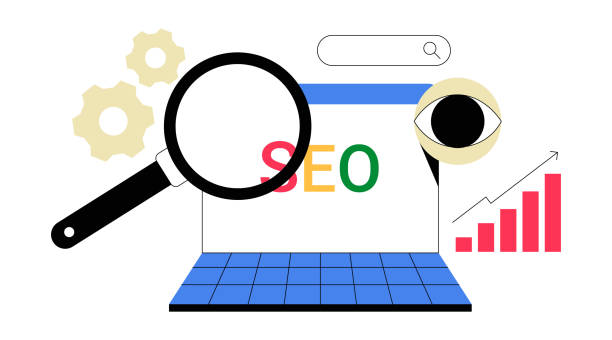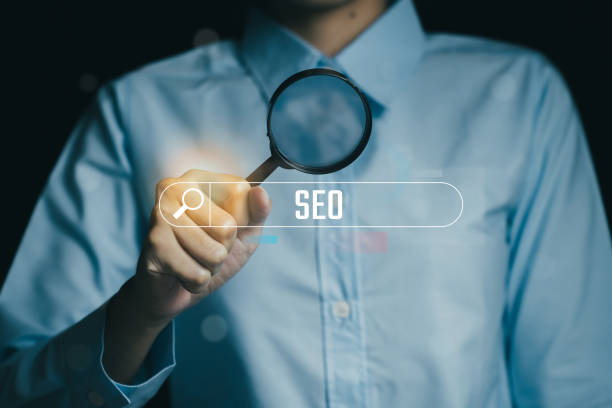What is SEO and Why Does It Matter?
What is SEO and Why Does It Matter?
#SEO, or Search Engine Optimization, is a collection of techniques and strategies used to improve a website’s ranking in the search results of search engines like Google, Bing, and Yahoo.
The ultimate goal of SEO is to increase online visibility and attract organic (free) traffic to the website.
In today’s world, where most people turn to search engines to find the information, products, and services they need, SEO plays a vital role in the success of businesses.
Strong SEO helps your website rank higher in search results, making it more visible to your target audience.
This leads to increased visitors, increased brand awareness, and ultimately, increased sales and revenue.
To better understand the importance of SEO, imagine you have an online clothing store.
If your website appears on the first page of Google search results for keywords related to clothing (such as “buy women’s clothing” or “latest men’s clothing models”), potential customers are much more likely to enter your website and buy from you.
SEO is a continuous and dynamic process that requires updating and adapting to the new algorithms of search engines.
In fact, SEO helps you optimize your website for search engines and users, ensuring that your content is accessible, relevant, and valuable.
This makes search engines recognize your website as a reliable source and rank it higher than your competitors.
Are you frustrated with the low conversion rate of your online store?
Rasaweb, with professional e-commerce website design, is your definitive solution!
✅ Increase your sales and revenue
✅ Unparalleled user experience for your customers
⚡ Get a free consultation now!
Fundamentals and Key Principles of SEO
Fundamentals and Key Principles of SEO
SEO is based on three main pillars: On-Page SEO, Off-Page SEO, and Technical SEO.
Each of these pillars plays an important role in improving your website’s ranking in search results.
Click here to preview your posts with PRO themes ››
On-Page SEO involves optimizing various elements within your website, including:
- Choosing the right keywords Research and select keywords related to your business that users use to search for your products and services.
- Optimizing titles and meta descriptions Writing attractive and relevant titles and meta descriptions that encourage users to click on your website link in search results.
- Content optimization Creating high-quality, valuable, and relevant content to target keywords that meet user needs.
- Image optimization Using high-quality images with appropriate size and adding alternative text (alt text) for images.
- Proper URL structure Using short, descriptive URLs containing keywords.
- Internal linking Creating links between different pages of the website to improve navigation and transfer SEO credit.
Off-Page SEO includes activities that take place outside your website and help improve the credibility and ranking of your website, including:
- Backlinking Getting links from reputable websites related to your field of activity.
- Content marketing Producing and publishing valuable content on other websites and social networks to increase brand awareness and attract traffic.
- Activity in social networks Creating an active presence on social networks and sharing your website content with audiences.
- Branding Creating a strong and reliable brand that is trusted by users.
Technical SEO involves optimizing the technical aspects of your website, including:
- Website loading speed Make sure your website loads quickly.
- Mobile optimization Make sure your website is optimized for mobile devices.
- Website structure Creating a logical and organized structure for the website.
- Sitemap Create a sitemap to help search engines index your website.
- SSL Installing an SSL certificate for website security.
Strategic Keyword Research
Strategic Keyword Research
Keyword research is one of the most important steps in SEO.
Choosing the right keywords helps you optimize your website content for your target audience and attract more organic traffic.
For keyword research, you can use various tools such as Google Keyword Planner, Ahrefs, and SEMrush.
Click here to preview your posts with PRO themes ››
When researching keywords, pay attention to the following:
- Relevance Keywords should be relevant to your business and website content.
- Search volume Keywords should have a decent search volume, meaning that a sufficient number of people search for these keywords per month.
- Competition Keywords should have relatively low competition, meaning that there are not many competitors ranking for these keywords.
- Search intent What is the user’s purpose in searching for the keyword? Are they looking for information, buying a product, or finding a service?
Keywords can be divided into three general categories:
- Head Keywords General and popular keywords with high search volume and high competition.
For example: “clothing”. - Long-Tail Keywords Longer and more specific search phrases with lower search volume and less competition.
For example: “buy black women’s party dress”. - LSI (Latent Semantic Indexing) Keywords Words that are semantically related to the main keywords.
For example: “fashion”, “style”.
Here is a sample table for categorizing keywords
| Keyword Type | Example | Search Volume | Competition |
|---|---|---|---|
| Head | Clothing | High | High |
| Long-Tail | Buy black women’s party dress | Low | Low |
| LSI | Fashion, Style | Medium | Medium |
Using a combination of head, long-tail, and LSI keywords in your website content can help improve your ranking in search results.
SEO helps you produce your content in a way that is pleasing to search engines.
Content Optimization for SEO
Content Optimization for SEO
Content is king! This phrase is very common in the world of SEO and indicates the importance of content in ranking a website in search results.
To optimize content for SEO, you need to create high-quality, valuable, and relevant content to your target keywords.
Your content should answer users’ questions, meet their needs, and encourage them to stay on your website.
When creating content, pay attention to the following:
- Content Structure Present your content in an organized manner using headings, subheadings, paragraphs, lists, and images.
- Readability Write your content in simple and understandable language for your target audience.
- Use of Keywords Use your target keywords naturally and intelligently in headings, subheadings, paragraphs, and alternative text for images.
Avoid overusing keywords, as this can lead to your website being penalized by search engines. - Linking Link to other pages of your website and also to reputable and relevant websites.
- Update Update your content regularly to keep it fresh and relevant.
There are various types of content that you can use for SEO, including:
- Blog Articles Blog articles are a great way to share your knowledge with your audience and attract organic traffic to your website.
- Product Pages Product pages should provide accurate and comprehensive information about your products and encourage users to buy.
- Service Pages Service pages should provide detailed information about your services and encourage users to contact you.
- Infographics Infographics are an engaging and visual way to present complex information to an audience.
- Videos Videos are a great way to engage audiences and increase interaction with your website.
Are you tired of your e-commerce website not generating as much revenue as it could? Rasaweb, specializing in professional e-commerce website design, solves this problem forever!
✅ Increase sales rate and revenue
✅ High loading speed and unparalleled user experience
⚡ Get free e-commerce website design consultation
Link Building: Creating a Network of Connections
Link Building: Creating a Network of Connections
Link building is one of the most important ranking factors in SEO.
Links show search engines that your website is reputable and trustworthy.
The more reputable and relevant websites that link to your website, the higher your website will rank in search results.
Link building is divided into two general categories: internal link building and external link building.
Internal Link Building is creating links between different pages of your website.
Internal link building helps search engines understand the structure of your website and identify more important pages.
Also, internal link building helps users easily navigate your website and find the information they need.
External Link Building is earning links from other websites to your website.
External link building shows search engines that your website is reputable and trustworthy.
The more reputable and relevant the websites that link to you, the greater the impact on your website’s ranking.
Link building is a time-consuming and challenging process, but it is worth the effort.
For external link building, you can use various methods, including:
- Producing high-quality content Producing high-quality and valuable content that others will want to link to.
- Participating in online forums and groups Participating in online forums and groups related to your field of activity and sharing your website content.
- Contacting bloggers and journalists Contacting bloggers and journalists related to your field of activity and asking them to write about your website.
- Link Exchange Exchanging links with reputable websites related to your field of activity.
Be careful to avoid unethical link building methods (such as buying links), as this can lead to your website being penalized by search engines.
Technical Optimization: SEO Infrastructure
Technical Optimization: SEO Infrastructure
Technical SEO optimization includes optimizing the technical aspects of your website that help search engines better understand and index your website.
Technical SEO optimization includes:
- Website loading speed Make sure your website loads quickly.
Website loading speed is an important factor in SEO ranking. - Mobile optimization Make sure your website is optimized for mobile devices.
Today, most users access the Internet through mobile devices, so mobile optimization is very important. - URL Structure Use short, descriptive URLs containing keywords.
- Sitemap Create a sitemap to help search engines find all pages on your website.
- Robots.txt File Create a Robots.txt file to tell search engines which pages on your website should not be indexed.
- SSL Use an SSL certificate to keep your website secure.
- Structured Data Use structured data to help search engines better understand your website content.
Technical SEO optimization can help improve your website’s ranking in search results and improve the user experience.
With specialized SEO, you can have the best performance in search engines.
Local SEO: Attracting Regional Customers
Local SEO: Attracting Regional Customers
Local SEO refers to optimizing your website to attract customers in a specific geographic area.
If your business has a physical location (such as a store, restaurant, or office), local SEO can help you attract more customers in your area.
SEO includes the following:
- Register with Google My Business Register your website with Google My Business.
- Optimize Google My Business Profile Optimize your Google My Business profile with accurate and complete information about your business.
- Get Customer Reviews Ask your customers to post reviews about your business on Google My Business.
- Use Local Keywords Use local keywords in your website content.
- Build Local Links Get links to your website from local websites.
Local SEO can help improve the online visibility of your business in your area and attract more customers.
Using SEO can have a significant impact on the growth of any business.
| Action | Description | Importance |
|---|---|---|
| Register with Google My Business | Creating and optimizing a business profile on Google Maps | Very High |
| Get Customer Reviews | Encourage customers to write positive reviews | High |
| Use Local Keywords | Optimizing content with keywords related to the geographic location | Medium |
Measuring and Analyzing SEO Results
Measuring and Analyzing SEO Results
Measuring and analyzing SEO results is critical to understanding the effectiveness of your SEO strategies and identifying opportunities for improvement.
Without measurement and analysis, you can’t tell if your SEO efforts are paying off.
To measure and analyze SEO results, you can use various tools such as Google Analytics and Google Search Console.
Some of the most important metrics to measure include:
- Organic Traffic The number of visitors who enter your website through organic search results.
- Keyword Rankings The ranking of your website for target keywords in search results.
- Click-Through Rate (CTR) The percentage of users who see your website link in search results and click on it.
- Bounce Rate The percentage of visitors who, after visiting one page of your website, leave your website without visiting other pages.
- Conversion Rate The percentage of visitors who perform a desired action (such as purchasing a product, subscribing to a newsletter, or contacting you).
By measuring and analyzing these metrics, you can identify the strengths and weaknesses of your SEO strategies and make better decisions to improve your website’s SEO.
#SEO is a continuous and long-term process.
Did you know that 94% of first impressions of a company are related to its website design?
Rasaweb helps you create the best first impression by providing professional corporate website design services.
✅ Creating a professional and reliable image of your brand
✅ Easier attraction of potential customers and improvement of online position
⚡ Get free corporate website design consultation
Practical SEO Tools
Practical SEO Tools
SEO tools can help you perform various SEO tasks, including:
- Keyword research Finding the right keywords for your business.
- Competitor analysis Analyzing the SEO strategies of competitors.
- Content optimization Optimizing your website content for SEO.
- Link building Finding link building opportunities.
- Rank monitoring Monitoring your website’s ranking in search results.
- Website analysis Analyzing your website’s performance and identifying opportunities for improvement.
Some of the most popular SEO tools include:
- Google Analytics
- Google Search Console
- Ahrefs
- SEMrush
- Moz
- Ubersuggest
Choosing the right SEO tools depends on your needs and budget.
By using SEO tools, you can improve your website’s SEO and achieve better results.
SEO is a science that requires appropriate tools for analysis.
Common SEO Mistakes and How to Avoid Them
Common SEO Mistakes and How to Avoid Them
In SEO, avoiding common mistakes can be as important as taking the right actions.
Some of the common mistakes in SEO include:
- Keyword Stuffing Overusing keywords in website content.
- Duplicate Content Using duplicate content on your website or from other websites.
- Broken Links Having broken links on your website.
- Ignoring Mobile SEO Ignoring website optimization for mobile devices.
- Buying Links Buying links from other websites.
- Ignoring Website Speed Ignoring website loading speed.
By avoiding these mistakes, you can improve your website’s SEO and avoid being penalized by search engines.
SEO requires compliance with the rules and regulations of search engines.
Frequently Asked Questions
| Question | Answer |
|---|---|
| What is SEO? | SEO, or Search Engine Optimization, is a process to increase the quality and quantity of website traffic by improving the site’s ranking in natural (organic) search results of search engines like Google. |
| What are the main types of SEO? | SEO is divided into three main categories: On-Page SEO, Off-Page SEO, and Technical SEO. |
| What does On-Page SEO include? | On-Page SEO includes optimizing elements within the website, such as keywords, page title (Title Tag), meta descriptions (Meta Description), content, URL structure, images, and internal links. |
| What is Off-Page SEO? | Off-Page SEO refers to activities outside the website that help improve its ranking, such as backlink building, social media marketing, and brand mentions. |
| What is Technical SEO? | Technical SEO focuses on optimizing the technical aspects of a website to help it be crawled and indexed better by search engines. This includes site speed, mobile-friendliness, site structure, sitemaps, and the Robots.txt file. |
| What role do keywords play in SEO? | Keywords are the terms that users enter into search engines. Using relevant keywords correctly and purposefully in content and site elements helps search engines understand the topic of your page and display it in relevant searches. |
| What is a backlink and why is it important? | A backlink, or inbound link, is a link from one website to another. Backlinks act as a “vote of confidence” from other sites for search engines and play an important role in the credibility and ranking of the site, especially if they are from reputable sites. |
| How does quality content affect SEO? | High-quality, relevant, comprehensive, and unique content not only attracts and retains users, but also shows search engines that your page is valuable. This helps improve ranking, reduce bounce rate, and increase the time a user spends on the site. |
| Why is site loading speed important for SEO? | Site loading speed is an important ranking factor for Google. Faster sites provide a better user experience, have a lower bounce rate, and are preferred by search engines. |
| Is SEO a one-time process? | No, SEO is a continuous and long-term process. Search engine algorithms are constantly changing, competition is increasing, and site content also needs to be updated. Therefore, SEO requires continuous monitoring, analysis, and optimization. |
And other services of Rasa Web advertising agency in the field of advertising
Smart Customer Journey Map: A combination of creativity and technology to increase sales through dedicated programming.
Smart Brand Identity: A professional solution for managing campaigns with a focus on SEO-driven content strategy.
Smart Marketing Automation: A new service to increase SEO ranking improvement by optimizing key pages.
Smart Social Media: A new service to increase digital branding through intelligent data analysis.
Smart Conversion Rate Optimization: A creative platform to improve campaign management with Google Ads management.
And more than hundreds of other services in the field of Internet advertising, advertising consulting and organizational solutions
Internet Advertising | Advertising Strategy | Sponsored Article
Resources
SEO Training – Zoomit
,SEO Training (SEO) for Websites and Business Systems – Part One – Aparat
,Complete SEO Training from Beginner to Advanced [What is SEO?] – Faraznetork
,What is SEO? We need to know about it – Chetor
? At Rasa Web Digital Marketing Agency, your online dreams come true! We bring your business to the peak of success by providing services such as dedicated website design, professional SEO, and social media management. Contact us today for a free consultation and build your digital future.
📍 Tehran, Mirdamad Street, next to the Central Bank, Southern Kazerun Alley, Ramin Alley, No. 6














